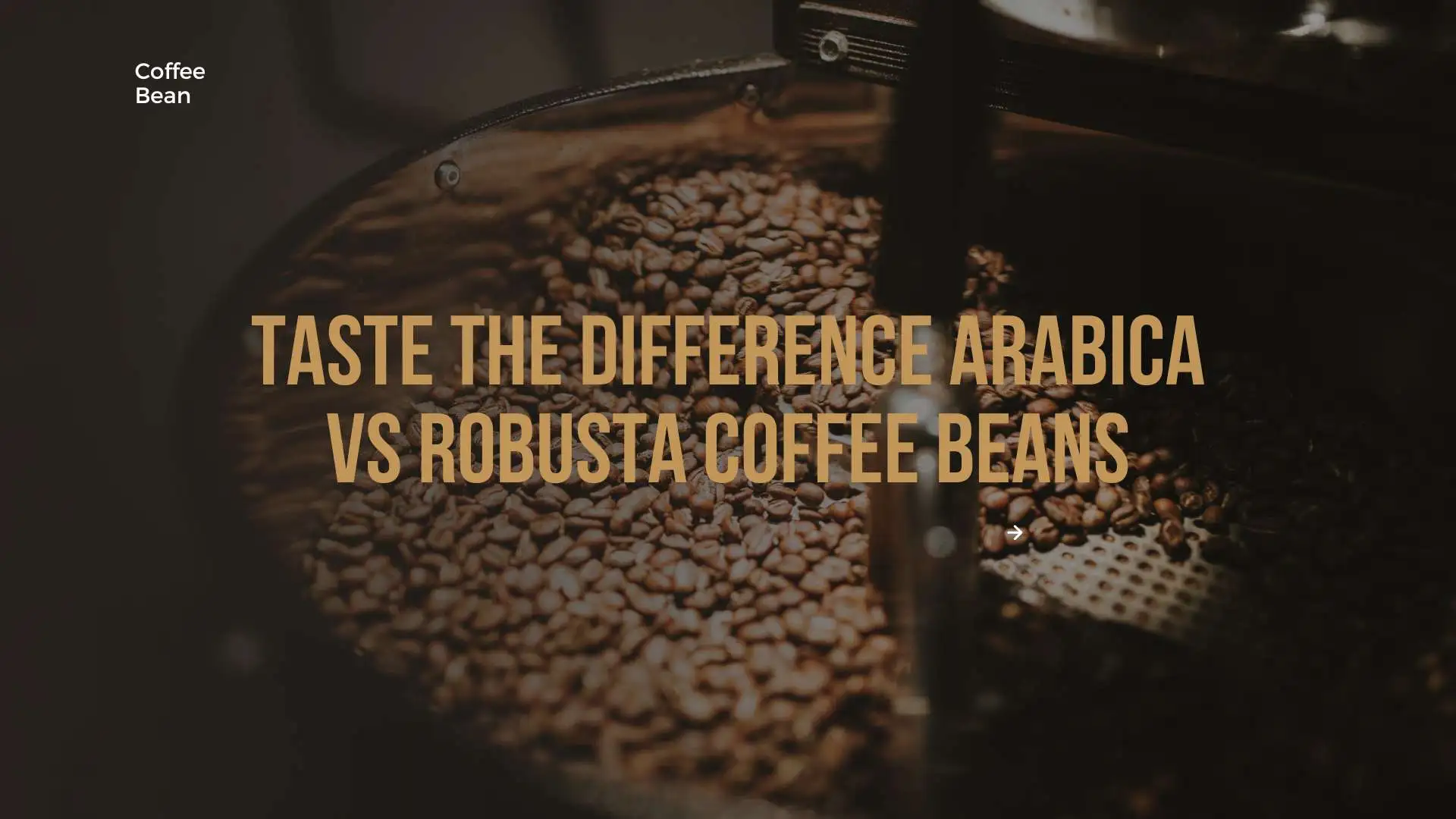Arabica vs Robusta Coffee
Coffee is very important to a lot of people, arabica vs robusta coffee and surprisingly, the type of bean you choose makes a big difference to the way it tastes with every sip; there are two main types of beans in coffee – Arabica and Robusta.
Now, I think, as you might also believe, that every small choice in making coffee, from the bean to the pot, sets the stage for your coffee’s story. Starting to explore where these beans come from, Arabica beans grow in the high mountains of Ethiopia, arabica vs robusta coffee enjoying nice weather around 2,000 to 6,000 feet above sea level; being so high up gives Arabica beans a special taste with flavors that can range from fruity to chocolaty.
People like Arabica because it tastes smooth and has less caffeine. Alternatively, Robusta is like the strong family member from the warm, flat places of Central and Western Africa. Robusta is only focused on staying alive and growing well, arabica vs robusta coffee showing its special skill to fight off pests and liking the warmer places below 2,000 feet.
If you’re someone who really likes strong coffee that wakes you up with its bold, bitter taste, Robusta’s high caffeine content and intense flavor will help you.

Arabica and Robusta beans don’t just grow in one place; they travel, showing up in the beautiful mountains of Colombia and the lively areas of Vietnam. They cross oceans and continents, creating a wonderful worldwide coffee community that’s about more than just drinking coffee for energy.
It may seem hard to believe, but we can bring happiness from their special places around the world right into our cups, arabica vs robusta coffee thanks to these beans being able to fit any coffee lover’s taste and way of drinking.
As I go further and tell you more about their stories – where they come from, where they grow the best, what makes them taste so different, and even amazing ways to make them – we’re all in for an experience that turns every coffee break into a discovery. Get ready to join me on this journey as we explore the flavors, places, and stories behind Arab cultures.
We will learn how a simple cup of coffee involves different names, colors, and many interesting details. The same we understand, coffee is more than just coffee. It’s a big place, asking us to enjoy and fully appreciate the variety of each cup one at a time.
What Sets Arabica and Robusta Apart?
Coffee lovers in the area know there’s an enormous difference between arabica vs robusta coffee beans, from how they taste and smell to how much caffeine they’ve got and where they grow. If you’re curious about the wide concentrated environment, or world, of coffee, understanding these differences is important.
arabica vs robusta coffee beans are famous for being quite unique, with complex flavors and nice smells that make them a favorite for people who love their coffee. These beans can taste like all sorts of things – flowers, fruit, nuts, and even chocolate. They’re very smooth and gentle, which means your coffee’s going to taste very even.
In addition Arabica beans don’t have as much caffeine, so if caffeine bothers you or you just want something lighter, they’re the way to go. Alternatively, Robusta beans have strong flavors, which is why people love them for espresso and coffee that really makes you feel alert; they’ve got this earthy, woody taste, sometimes even a bit spicy, and they’re a bit on the bitter side.

What really sets Robusta apart is that caffeine kick – it has nearly twice the caffeine as Arabica, fitting for those who need more energy or love a deeper coffee taste. Besides what they taste like and how much caffeine they have, arabica vs robusta coffee where and how these beans grow is a different story.
Arabica plants do their best in very nice places high in the mountains, arabica vs robusta coffee from 2,000 to 6,000 feet above the ground; they need a lot of care because they’re quite delicate and can easily get sick or attacked by pests. Robusta is the hardworking relative here, thriving in warmer spots closer to sea level; they’re very strong, standing firm against pests and sickness, which makes them easier to look after and less likely to get sick.
Both Arabica beans and Robusta beans are big deals in the coffee world, offering their own unique characteristics and tastes. Whether you’re solely focused on that gentle, complex taste of Arabica or you’re into the bold and strong spirit of arabica vs robusta coffee, there’s definitely a type of bean that’ll match how you enjoy your coffee.
Now, a discerning reader, such as yourself, will surely comprehend that each of these beans brings something special to the table.
And with such variation, there is unsurprisingly a potential to find exactly what suits your taste friends and morning routine. Whether it’s bold or subtle flavors, more or less caffeine, each in practice bean has its fans and location in coffee’s broad spectrum.
Growing Conditions and Cultivation
arabica vs robusta coffee, the two main players in the coffee game, require different characteristics to really thrive. Depending on which bean we are discussing, farmers must change their game. Growing coffee isn’t simply about tossing seeds in the ground and waiting for magic. It’s a whole science, person; to take the most advantage of their crops, coffee growers need to secure the environment and care these beans demand.
Almost inevitably, we see arabica vs robusta coffee being solely focused on that highland life. These beans need special qualities, growing best in warm places where they get to rest in hidden spots under trees. It’s solely focused on that altitude life for them, with their best height hovering between 2,000 and 6,000 feet above the ground.

The better temps up high slow down their ripening, which is of significant consequence. It gives Arabica beans their standout taste by letting the flavors get more complex through the months and years–but it’s not all easy-going for arabica vs robusta coffee; they’re prone to catching illnesses such as coffee leaf rust. Surpass that, and you have quality beans on your hands.
Changing things around, arabica vs robusta coffee is the tougher sibling. Heat? Loves it. Constant sunlight? More, please. These beans grow in the lower lands, under 2,000 feet, where it’s bright and hot all day. Robusta doesn’t need a tree to hide under – it’s solely focused on soaking up as much sun as possible.
In addition they’re like the tanks of the coffee world, hardy against the elements and less fussed by pests–but don’t think it’s easy. The arabica vs robusta coffee berry borer bug can still destroy havoc if farmers aren’t careful.
It’s absolutely undeniable that if you want a really good cup of coffee, you must know what’s happening with Arabica and Robusta beans. arabica vs robusta coffee beans are solely focused on those high altitudes and better spots, whereas Robusta beans like the heat and lowlands. Weirdly enough, this notion about the places they like to spend time is extremely crucial – and not simply for fun.
It shows we respect Mother Nature every time we fully enjoy our regular water. Each type of bean, be it arabica vs robusta coffee, demands special care to flourish; this means farmers are in the area working hard, adjusting the soil and water just right, fighting off pests, maybe trying new and different options with different crops, or turning waste into compost to keep the ground beneath their beans in excellent shape.

We can take as a definite certainty that knowing the specific xxx on where and how these beans grow is very important. Shifting gears, the efforts of arabica vs robusta coffee producers to cultivate everything in an eco-friendly way, innovating and keeping the ecosystem in balance while they do it, are honestly making a very good effect in relation to our planet.
Surprisingly, doing right by Mother Nature ends up benefiting us too, offering endless cups of joe and nudging our planet in a healthier direction. Spotting labels like Fair Trade or Organic on your arabica vs robusta coffee means those behind the bean are treated right, and by buying it, we’re doing our part to help mend the world a bit.
Processing Methods
Taking a arabica vs robusta coffee cherry and turning it into our much-loved coffee brew requires several steps that really shape how it tastes, how it smells, and how good it actually is. We see all sorts of tactics from old methods to the latest technology being used by coffee makers to make these amazing beans ready for our morning cup.
It’s absolutely undeniable that the manner arabica vs robusta coffee beans get processed, matters a lot. Now, when it comes to Arabica beans, mostly, they’re dealt with in three ways: they either get washed (that’s wet processing), sun-dried with all their components on (which means dry processing), or they go through honey processing (also known, more simply, as pulped natural).
Wet processing wipes away the outer layer and pulp and then has the cherries sit in water to get the gooey material off the beans.
Afterward, the beans are washed again and dried, making them give off extremely clean and sharp tastes that arabica vs robusta coffee is famous for. Dry processing is simply putting the cherries out to dry in the sun. This allows the beans to soak up all the sugar from the fruit, which gives the coffee a rich, fruity taste and makes it feel thick.

Honey processing basically combines both, leaving some pulp on the beans as they dry, sticking to them like honey–and making the coffee taste sweet and complex. For Robusta beans, the scene is a bit different. Traditionally, they just let the cherries sit in the sunlight on big racks or mats, letting nature bring out those bold, intense flavors that make Robusta stand out.
Lately, though, mechanical methods are getting the spotlight, especially where they make a large amount of arabica vs robusta coffee. This includes machines that peel and pop out the beans, making everything faster and cutting down on the labor.
They may potentially even use some fermentation tricks to make the flavor stronger and remove the leftover stubble on the beans. Of course, it is moreover apparent to you and I that where these beans end up – quality-wise – depends jumbo on those last steps after the processing industry is over.
I’m speaking sorting, grading, and tucking them into storage real nice to make sure they stay good and yummy until they hit the roaster. arabica vs robusta coffee people are also getting into using water more wisely and turning the cast-offs into compost so they’re not only making great coffee but doing it without destroying the planet and looking out for everyone involved.
If you love coffee, learning about the different ways it is made is like discovering why your coffee tastes the way it does. Whether you like the clear, sharp taste of a washed Arabica or you prefer the deep, fruity hit from a natural arabica vs robusta coffee, there’s a coffee process specially made for your taste buds.
Global Production and Consumption
People all over the world can’t seem to get enough coffee, and this craving just keeps getting bigger. The whole coffee buzz is powered by drinking a lot of arabica vs robusta coffee beans. Next we engage in an intense examination of where these beans come from.
They don’t only suddenly show up – they’re grown in places ranging from the beautiful mountains of Latin America to the hot forests of Southeast Asia. Every location contributes uniquely to this massive interactive concentrated environment, or world, of coffee tastes and the industry.
It may seem hard to believe but we can take comfort in the fact that Arabica beans are significantly different from your usual beans. Next we engage in an intense examination of how these beans grow well high up in places called the Coffee Belt – several countries sitting on the equator perfect for arabica vs robusta coffee growth. We are discussing wonderful spots such as Ethiopia, Brazil, and Colombia.

It may seem hard to believe but we can take comfort in knowing that these specific spots are first rate at growing arabica vs robusta coffee, especially the high-quality Arabica sort.
The reason they’re so successful is that the weather is very calm, there’s a lot of rain, and the soil has volcanic material in it, which is really great for these coffee plants. Even though arabica vs robusta coffee beans have less caffeine and cost more money than Robusta beans, they’re still a hit among coffee enthusiasts and shops.
This loves got a lot to do with the unique spots they grow in. A discerning reader, such as yourself, will surely comprehend why these beans are preferred despite the higher cost.
When discussing arabica vs robusta coffee beans, one observes they sprawl out mainly in the toastier, lower areas of Africa, Southeast Asia, and a bit in South America. It’s Brazil, Vietnam, and Indonesia turning out the majority of the world’s Robusta beans; they’re very important in the coffee industry; these beans stand out for their strong flavor and high caffeine content, placing them at the center of many espresso blends and instant coffees.
And here’s something binding — almost inevitably, we see these strong beans lead the race in crafting the creamy espressos and quick coffees we love so much. One can see — unquestionably so — they’re critical in the concentrated environment, or world, of coffee.
When wondering about which coffee beans are the top choice, arabica vs robusta coffee beans quickly come to mind; these beans don’t only appear in special coffee shops and snack places for no reason; the hermetic result of this is that we can easily see it’s abundantly obvious that they’re number one.
A little surprisingly, their widespread availability allows everyone to look into a variety of coffee tastes from all corners of the globe, thanks to Arabica’s diverse and distinct flavor. However, it’s worth mentioning that Robusta beans hold their significance too.
Let’s change the topic and talk about arabica vs robusta coffee beans for a minute. They stay in the everyday brew—think your quick instant coffee fix in the morning, the hard-hitting espresso blends, or the regular cup of coffee from the corner shop.
They may potentially not get the hype that arabica vs robusta coffee does with its fans–but their strong flavor and the buzz you get? That material powers a significant quotient of the popular coffee styles we can’t seem to get enough of—a significant quotient of people like them for that reason.
While people are enjoying arabica vs robusta coffee beans for their great taste that’s popular around the world, Robusta hasn’t been forgotten. They’ve got a group that appreciates their in practice coffee too, especially in those drinks we grasp without thinking twice.

Delving into the bucks and community aspect, one can see — unquestionably so — that both Robusta and Arabica beans play vital roles. Starting with the small-timers on the hills to the vast spread on the fields, these arabica vs robusta coffee beans do more than just grow.
They become a critical part of keeping people together, alive with culture, and sustaining a real line of traditions worth passing through generations.
Across several places where it’s extremely important to save cash and using material needs to be simple, Robusta beans are very important. Don’t simply sideline Robusta beans because they don’t cost a lot or don’t seem as high-quality as arabica vs robusta coffee ones.
In discussing the massive impact it’s not only about making coffee — it’s how people stay connected, keep their group close, and make sure old family traditions keep going. And in the final analysis, one finds that the hermetic result of this notion governs the manner we interact with each other.
There is unsurprisingly a potential to cover our cafe needs economically, offering a balance between keeping prices down and being obtainable. Even if it’s not very famous for some, these plain beans are able to stay smooth to fulfill the giant craving for the much-needed caffeine fix the world craves.
Next we engage in an intense examination of coffee beans, arabica vs robusta coffee; they matter a lot because of their different flavors. Robusta beans give your coffee a solid, hefty flavor, — separately –, Arabica beans are solely focused on making your coffee smell incredible and taste extremely great.
It’s crucial how you put together your arabica vs robusta coffee since it needs to highlight the bean’s flavor. Arabica beans are amazing, offering your coffee a fab taste and a bouquet of wonderful scents. And in the form off analysis, June finds that these bean types affect your coffee experience extremely.
For these beans, there are a few ways to brew that work best:
– Starting with the AeroPress, it’s a marvelous device that lets you disaster around with how you make your coffee, like changing how big the coffee grounds are, how hot the water is, and how long you brew it. You might end up making an Arabica coffee that’s smooth but still hits all the right notes similar to when you use a pour-over–but without much fuzz.
– Discussing pour-overs now, which involves techniques using items such as a V60 or Chemex, it’s in practice prime for arabica vs robusta coffee. You must be all precise with how hot the water is and how you pour it–but if you get it right, you get a coffee that’s just *chefs kiss* because it somehow catches many gentle, special tastes and smells, from flowers to fruits, and maybe even chocolate.
– Last up, by using a French press, you just let your Arabica grounds relax in hot water for a few. It doesn’t get easier than this–but yet you have coffee that’s rich and feels like a hug because it pulled out many oily flavors and intense tastes.
When you break down many highly engineered brewing paths for Arabica beans, we can easily see that it’s abundantly obvious that picking just the right one can make your coffee go from good to amazing.
And the hermetic result of this is that once you know your beans and how to brew them, you’re going to make some top-tier cups of coffee, whether you’re all in for the soft and aromatic tales of Arabica or leaning toward the no-joke strength of Robusta.
Robusta Coffee Beans
It’s not hard for one to imagine loving the powerful and full-on taste of Robusta coffee beans. Although it may seem strange, these beans have a strong and bitter flavor, making them very good for drinks where you really want to taste the coffee. When it comes to making a great coffee with Robusta beans, there are a few recommended methods to really make their strong flavors shine.
Espresso is a primary because Robusta beans work so well in it; their high caffeine hits hard and adds a rich bitterness that makes your espresso shots have a thick, creamy top and a taste that wakes you up.
Then, there’s using a Moka Pot, also known as a simple espresso maker. It’s wonderful for a good reason. It shoots hot water right through the finely ground Robusta beans, making a coffee that’s not only bold but also perfectly dense and rich: if you’re into espresso-style drinks like hot coffee or sweet milk, this method is king.
And don’t forget about the Vietnamese Phin filter. It’s this wonderful, slow drip method to make coffee that’s greatly popular in Vietnam for Robusta beans. It grasps onto all those hearty, ground-flavors and puts them directly into your cup–providing you a strong, earthy energy kick that’s hard to find anywhere else. By choosing the best brewing method for Robbia or even Arabica beans, it’s a simple choice to bring out the top tastes for your ideal cup of joe.

Conclusion
The coffee world is calling with this ongoing face-off between Arabica and Robusta beans, and you may be slightly unsure that something as simple as coffee beans can make such an enormous difference in the taste of your coffee. There’s a competition going on right inside your cup. We must face it — we can take as a definite certainty that the beans you choose to brew your coffee really does matter.
You’re choosing what to brew next? Getting down into the specifics, Robusta beans are solely focused on giving you that sharp taste and serious jolt of caffeine to get you through your day. Brew it any way you want – an espresso, a traditional Moka pot, or Vietnamese-style with a Phin filter – and you’ll get that intense flavor and caffeine kick.
On the side of the ring, Arabica beans are the ones that bring in those smooth, varied flavors. People who prefer a milder, more aromatic coffee lean towards Arabica; these beans give you floral notes and a less sour cup whether you’re making your drink with a pour-over, French press, or an AeroPress. At the end of the day, when the question is whether to choose team Arabica or team Robusta, the choice depends on what tastes better to you and how you like your coffee to make you feel.
Next morning, as you’re setting up your coffee, pause a minute to think about these beans and their journey. A tad surprisingly, appreciating the beans’ taste and their lines can change your whole coffee experience, making each sip reveal something amazing: everyone’s got their champion bean in this brew-off, with unique tastes steering the ship.
If you’re wondering about which coffee bean is the best – Arabica or Robusta that’s up to what you like taste-wise. Arabica’s all smooth and chill–but if you’re into something that is very strong, Robusta is the best choice with its bold characteristics.
And Mixing Arabica and Robusta beans is an interesting idea, and it’s not hard for one to imagine why. Coffee bright people do it all the time to get the perfect mix of smooth and bold.
Now, let’s talk about the fun part of caffeine – you might think Arabica’s leading the race–but no, Robusta’s the heavyweight here. It’s got about double the caffeine of Arabica, so it’s not only bold in taste but also helps you wake up more.
It is moreover apparent to you and I that hacking your way through the concentrated environment, or world, of coffee offers more than a pickup. Sipping on Arabica or Robusta could be helping you because they are full of antioxidants. However, let’s be honest – their effects on your health can vary greatly for each person.
FOR MORE










